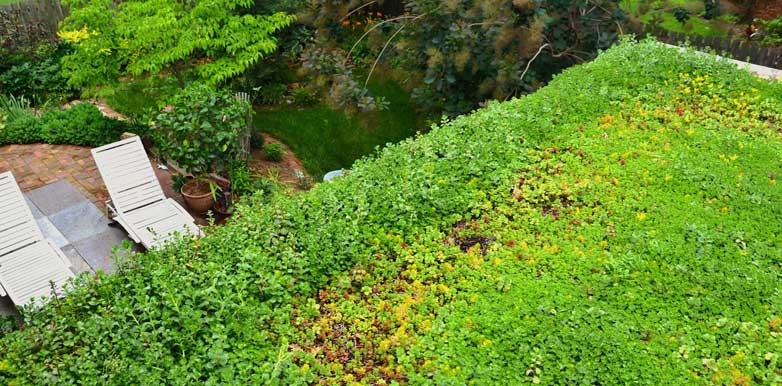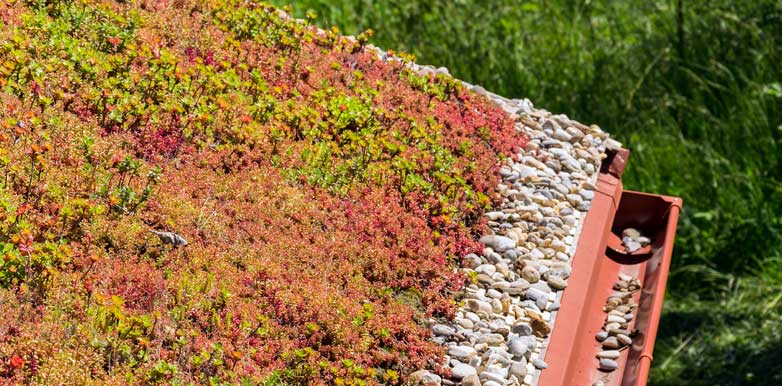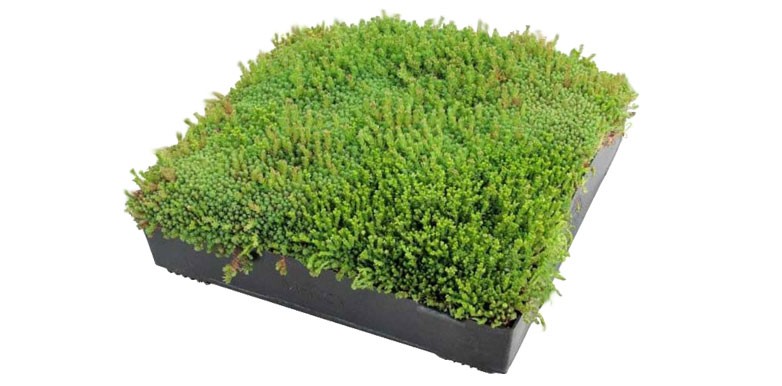How to Maintain a Green Roof

Although they’ve gained popularity amongst contemporary home designers in recent years, green roofs are nothing new. Looking back through time, different conceptions of the “green roof” have been used throughout history; including the Hanging Gardens of Babylon, constructed in 500 BC and considered one of the Seven Wonders of the Ancient World. However, we don’t all live in Ancient Mesopotamia, but a thick sedum roof can still provide many benefits to a modern home, so it’s vital to keep yours well-maintained.
Green roofs are also enjoying significant use throughout urban areas, where they are used to create much-needed habitats for wildlife. This is a fantastic way to maintain a greater balance with nature, and inject a bit of the countryside into the city. Green roofs also help to reduce energy bills by improving insulation, and they help to combat air pollution in their surrounding environment. Green roofs are also fantastic during hot weather, helping to keep the space below cool.
Adding greenery to an urban environment also has significant benefits for mental health. According to the NASA Earth Observatory: “Green space most strongly protects against mood disorders, depression, neurotic behaviour, and stress-related issues, the study found, signalling that psychological restoration may be the strongest protective mechanism that green space offers. The effect of green space is also dose-dependent, meaning those who have longer exposures to green space have greater mental health benefits.”
If you’re still on the fence about installing a green roof kit onto your property, we’d recommend our introduction to green roofs. Or, if you’ve installed a green roof already, you’ll need to learn how to keep it looking and performing at its best. This handy blog post will talk you through all of the key steps in maintaining a healthy green roof.

Basic Green Roof Maintenance
Any green roof should undergo at least full two inspections a year to check roof outlets, discover any remedial work that needs doing, remove debris and apply fertiliser to promote healthy growth. This is the foundation level of maintenance that you can generally expect for all green roofs, however dependant on which type of green roof you have installed, the degree of this upkeep will differ.
For instance, many green roofs such as the M-Tray are made up of low-maintenance sedums. This means that the upkeep needed is significantly less than alternative options. Another lower maintenance option is a biodiverse roof which is designed to remain as organic as possible, appealing to the natural fauna and flora of the region by allowing self-seeding. Taking a hospital in Boston as an example, they have utilised their green roof as a vegetable garden used to feed doctors and patients as well as teach people about the importance of diet. With growing vegetables in this, a green roof in this form will definitely require a significantly higher level of maintenance and care.
However, when most people think of a green roof, they will most likely be considering the use of wildflowers and sedum. This is arguably one of the easiest choices, with lesser maintenance than just simple grass. As with any plants, sedums do still require attention throughout the year although growth is much slower in the autumn and winter months. This type of green roof is what we will mainly be focussing on throughout this article.
We have broken down the areas of maintenance into eight helpful sections with some extra handy tips included along the way.
8 Ways to Maintain Your Green Roof
Weeding
Weeding out unwanted plants is a vital step to keeping your green roof healthy and growing. Just like in a regular garden, if you let weeds run free, plants can become quickly crowded and cause problems. Weeds commonly found on green roofs include tree seedlings, grass and moss. Sedums are renowned for spreading quickly which thankfully means that weeds don’t often get a chance to grow and take hold, therefore the amount of weeding needed will be minimal.
Weeding will be required more often in the spring and summer months; however, the process is still relatively quick and easy. Simply remove the weeds by hand as and when you spot them, which if your roof space isn’t too big can take as little as just 30 minutes.
Watering
Even though sedums are particularly hardy and can easily survive on little water, it is still important that you provide them with a considerable amount of water after installation as well as during the first few months of growing. You will also need to water more regularly in hotter, summer months to keep them at full health. An irrigation system is a popular choice that many have installed which helps in controlling the right amount of water that your plants need, therefore lessening the work for you. If your roof isn’t that big or you are prepared to keep up with any watering required, this generally is not necessary, but you should still ensure that you consider the closest practical water point before making that decision.
Feeding
A fundamental way of keeping your green roof healthy and full of life, is by feeding it with purpose-made living proof feed on an annual basis. This means feeding at the beginning of spring in March or April time to ensure your green roof has all of the necessary nutrients it requires to grow, survive and flourish. You can alternatively feed any time between February and August if you miss this time period, but March or April is the preferred timeframe. You should definitely avoid feeding your roof in colder months as new growths will occur because of the added nutrients but are highly suspectable to frost damage.
To guarantee optimum results, you should be using a slow-release feed that incorporates an appropriate amount of Phosphorous and Potassium to boost healthy root and flower growth with levels of Nitrogen at 8% or lower as too much can encourage lush growth which is susceptible to frost and wind damage.
If you are struggling to find the right feed for your green roof, then it is a good idea to ask the company that you purchased your green roof from, what they recommend. Often, manufacturers can even have their own mix of feed available that is aimed specifically at the plants on your green roof.

Monitoring Poor Growth Areas
If you are noticing that some areas of your green roof are simply not growing or that the sedums are not filling gaps even after they’ve been fed, then it may be necessary to sprinkle down a little more sedum seed down.
However, poor areas of growth may be down to other feeding problems. Your green roof should only need one feed per year however if you spot any of the below then it may need two or three feeds a year. It is important to make sure that there is a gap of 6 weeks between each feed and that feeding is done in spring or summer during the growing season.
Changes in colour – If you have a wildflower green roof then you should be seeing a mass of vibrant green colour flourishing. If this colour has turned yellow or brown, then it probably is in need of extra feed. If you have a sedum covered roof, then you shouldn’t worry when it turns to a reddish colour during the winter months as this is normal and should return to it’s normal green by the end of March. If, however, you are not noticing this regular colour change and that they are not flourishing to green during the spring and summer period, then they may be lacking in nutrients which may mean require more feed or a different kind of feed.
Gaps in the coverage – Big gaps in the coverage of your green roof can be a red flag that some of your plants have died due to a lack of nutrients. Again, this could be caused by a lack of feeding or that you are using a feed that doesn’t include the appropriate levels for your plants.
General lack of growth – During the summer months, the amount of growth from week to week should be fairly noticeable. If you are not noticing considerable growth during this time period, then this could indicate that they require an additional feed. A handy way of monitoring the growth of your green roof week to week is by taking photos of the foliage regularly to see the difference or lack there of when comparing the pictures.
Cleaning Debris from Drains
One of the fantastic advantages of the green roof design is that it reduces rainwater runoff from the roof. However, you will still need to clean out your gutters from time to time as you would with a regular roof. It is recommended that you check and clear your gutters two times a year; once in the spring and once in the autumn. Due to the nature of a green roof, you may also see an increase in foliage in the gutters that also need clearing out, so it really is about just keeping an eye out to prevent any potential problems.
Irrigation System
An irrigation system is used to water crops with controlled amounts of water to promote healthy and consistent growth. They are not necessary to install with a green roof, although they can be helpful to ensure that your plants are always adequately watered and to reduce the workload for yourself.
If you do have an irrigation system this will need to be checked from time to time to ensure that everything is working correctly and to see if the timer batteries need replacing.
Pests/Unwanted Wildlife
Even though a green roof makes a fantastic habitat for wildlife and insects, sometimes unwelcome pests can cause significant damage to your green roof, especially if you are using it to grow vegetables. These may include insects such as ants, birds, mice, rats, mosquitos, large cockroaches and termites. After closely monitoring the situation, if you have noticed that you do have a pest problem that is causing harm to your green roof, then the best bet is to consult a professional for advice on how to safely and effectively solve the problem without causing any unnecessary harm to wildlife or your plants.
Weather Damage
Although green roofs can be left to survive pretty naturally as a garden would, if you have noticed more extreme weather conditions such as a heavy storm recently, then it doesn’t hurt to give your green roof a check over to see if any damage has been done and repair accordingly.
To Conclude
The information above is a good guideline for both green roof trays and roll-out green trays but it is still very important that you check the maintenance requirements when purchasing your green roof as all green roofs can differ in terms of the upkeep needed. Make sure you ask whoever you buy your green roof from for their professional advice.
If you would like to find out more about green roofs you can find further information in our article - An Introduction to Green Roofs. We also have a wealth of information available on the individual product pages for Wallbarn’s M-Trays including how much each tray weighs, both when it’s dry and when it’s wet. Again, it is always advised to speak to a structural engineer before installing a green roof to find out if your roof structure is strong enough for the additional weight.
For any other questions or queries about our m-trays, don’t hesitate to contact our friendly customer service team either by phone on 01295 565 565, by email or via our live chat.